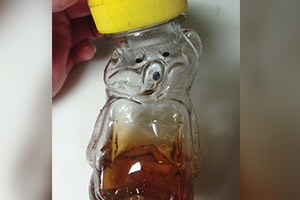Don’t Do This
SO appreciate your column and all the information and advice you provide! It’s the first article I read in the ABJ!
I discovered the hard way that the plastic honey bears are not made the way they used to be! I had two jars that had crystallized. Not wanting to risk of distorting the bears in hot water or a microwave, I put them on the dashboard of my car on a warm 65 degree day, thinking the sun would warm and liquefy the honey. Imagine my surprise (and horror!) when I opened my car door after work and saw that the bears had melted and the honey was dribbling into the vents of my car!! The honey had run through the vents and was dripping onto the floor of the car. UGH! What a MESS!
The car runs fine, although flies and bees tend to fly in when I leave the windows open, but the bears were mostly unusable.

Thanks again for your wonderful column!!
Glass Please!
BB, Someplace in the Midwest
Photo Caption:
Melted honey bear
Q HOW TO GET BEES TO DRAW FOUNDATION after the Nectar flow
Is there a secret to getting bees to draw comb on new foundation after the nectar flow? I feed with a 2:1 sugar: water because it doesn’t ferment or mold, and there is less water for the bees to have to evaporate. Is 1:1 a better solution? I use wax coated plastic foundation and sometimes paint extra wax on it. Thank you for sharing your experience and wisdom.
Ken Klotz
A
Experience and wisdom. You made me smile. My day was spent extracting and cleaning up today. If I was as experienced and wise as you say and not so beekeeper cheap, I wouldn’t have been so inefficient with the several hundred pounds of honey from the partnership I have with my backyard colonies.
Great question and wouldn’t it be cool if “we” beekeepers could manage to turn on this comb building biology at will? The best we can do is influence it. If it was just feeding carbs in the form of sugar syrup, that would be easy. To make this happen it is the influence/combination of internal intervention (feeding) and external from blooming flowers producing nectar and pollen. The cue the colony is looking for is not only lots of nectar/sugar syrup, but pollen to support the potential of colony growth and population stability if not increase.
Successful beekeeping, however you measure it, is a numbers game. More bees is better than fewer bees. Drawing out foundation only happens when there is need for room to raise brood, store nectar or bee bread. Comb is absolutely necessary for colony survival. No comb, no colony. It is biologically foundational to everything. But, if there are not X number of bees that need X amount of room for short-term or long-term storage, then very little you do will make any difference.
I hope you don’t get discouraged, but you have accepted this relationship with an insect; it’s relationship with many parts and pieces in a sometimes hostile environment. You have to be aware, flexible, patient and willing to accept being humbled. If you are, it is an amazing and fun
journey. Enjoy.
Q MORE ON THE SMALL HIVE BEETLE
As I was extracting my frames, I came up with questions on my small hive beetle (SHB) problem…and what to do with slimed honey? I had the idea of putting black plastic down on the ground just about all around the stand. I pinned it down with nails and laid 2 x 12s on top to get it as close to the ground surface as possible–out 4 feet in all directions. Let’s see the beetle larvae try to get through that! I had spilled a number of larvae as I was removing the damage.
Do you have a preference on Beetle Blasters, Beetle Jail (which looks very good to me but buddies say bees will propolize it). A company also makes an entrance they say filters out the beetles. Is that a good product? Thanks again for everything.
Best,
Kerry
A
Sorry to be a potential pain in the butt, but I want to emphasize that SHB is a SECONDARY predator of honey bees. Once they realize that they (SHB) can lay eggs because there are not enough bees to protect the colony, it is all over with. Trying to control SHB larvae after they have destroyed the colony and using Gard Star, nematodes, black plastic, concrete or stainless steel simply doesn’t work because the colony has already been overwhelmed and destroyed. SHB larvae will crawl up to …


